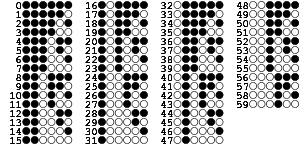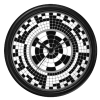
|
|
How to: Convert an analog wall clock into a binary clock November 9 2006Analog binary wall clock Add some binary to your daily life. Besides providing ultimate nerd bling, clocks and watches that display the time in binary are an extremely useful educational tool. These clocks bring binary numbers to everyday life, and after using them for some time you'll learn to read binary numbers fluently. Clocks that display time in binary commonly use LEDs to display the current time as binary numbers. Here's a different way to easily construct a binary clock, based on a cheap analog clock. At the end of the conversion, you'll have a clock that shows the time in both analog and binary. The clock-mod involves printing, cutting and glueing, no electronics skills are required. Patterns that allow you to create your own analog binary clock are provided at the end, in PDF format. Related items: "True binary time" wall clocks and my friend Walter's PIC implementation of a binary clock. An analog clock that also shows the time in binaryHere's an analog wall clock that also displays the time in binary. Both hands are modified into circular, punched disks that rotate and display a binary number each, one for the current hour and one for minutes. The hands are cut out templates that carefully align with a backdrop to show binary numbers in the clock's hour and minute hands. As such, the clock displays the current time in both analog and binary. Because the mechanisms of this clock do not require any electronics, but purely the mechanical rotations of the hands, it is a true "analog binary clock." My mounted analog binary wall clock displays 11:40. The clock has been running for some time now, and is still on-time. In the above image, you can see my implementation of the clock. The photo was taken at 11:40. Reading the binary numbers from the inside out, the small hand shows the binary number The bit of the number that is displayed at the outer edge, is the least significant bit. If the bit is white, it is on and denotes 1. The bit is 0 otherwise. The next (moving to the center) bits represent 2/0, 4/0, 8/0, 16/0, 32/0 if these are on/off. Adding these powers of 2 gives you the number represented by the binary number. The list below shows all binary numbers from 0 to 59. Their last bits are the least significant.  The binary format for numbers 0 to 59. With six bits, we could've gone up to 63. For higher numbers, we need more bits. Since the clock shows the time in analog as well as binary, the analog format provides you with an estimate of the current time. Based on that, it is easy to figure out the exact time (in minutes) from the binary numbers, and the analog estimate serves as a check for the math. You'll learn to read binary numbers in no time (sic).  My other implementation of an analog binary clock, based on an IKEA Susa clock. Photo was taken at 3:41. See if you can read the time on the clock below. A simulation of the analog binary clock, in Flash. The simulation shows your computer's current time in both an analog and binary format. The hands move slowly, in real time. If you look at the simulation for about a minute, you'll see how the clock goes from one minute to the next. As the hand moves from one number to the next, at least one bit changes (the least significant bit always changes color). If the window is in between two numbers, you can see an edge between the changing bits. When the hand is halfway through this change, it denotes the step to the next minute or hour. InstructionsOK, let's build one. You'll need the following: A hackable analog clock, printer, PDF patterns (see below), thick (grey) paper, transparent plastic sheet, glue, scissors, hobby knife. This clock can easily be constructed by hacking a cheap retail analog clock. I found a pretty big one (27.5cm diameter for the backdrop) for 12 euros, and it was perfectly hackable as it could easily be taken apart and put back together. I'm sure good clocks can be found for half of that, or as second hand. For the conversion, the clock's backdrop is changed, and its hands are modified so they can be replaced by the rotating disks. A hackable clock allows you to access the hands, and take them out so you can glue a new background image on the clock's face, and modify the hands themselves. Scissors can easily shorten flat metallic or plastic hands. Flatter hands are better. Make sure that you can print patterns large enough to cover the clock face. Since I have access to print on A3 format, I can create clocks with a 30cm diameter. If you're limited to using A4 format, your maximum diameter is about 21cm. The background image displays all required patterns of binary numbers. The inner 4 bands represent the binary numbers from 0 (all black, on top) to 11 (  The dial for the clock. The patterns show binary numbers for hours and minutes. The hands require more crafting time. I've cut out thick paper based on the patters below. The blue lines represent cutouts for the outer hand. The red lines are cutouts for the smaller, inner hand. The outer hand is glued onto transparent plastic. Both templates are then connected to the original clock's hands that have been shortened so they don't show. PDF patterns for the minute and hour hand are provided below.  Pattern for the templates to serve as the clock's hands. Patterns, PDF filesBelow are the PDFs that I have generated (with code that generates xfig files) for my clock. The patterns are based on a clock that is 27.5cm in diameter. An inner circle with a 6cm diameter serves as a margin and to connect the clock's hands to the new dials. There's a 1cm margin on the outer edge of the dial. These PDFs were printed on a 1:1 scale on A3 paper. If your clock's diameter is xxcm, print the files on a xx:27.5 scale.
The overall method can be simplified in various ways. One way is to just change the dial of the clock, and leave the hands as they are. Hands shaped as windows instead of full discs can also be used to emphasize the current time in binary. The conversion of watches also seems plausible. Order an analog binary clock onlineBelow is my design for an analog wall clock that allows you to read and learn about binary time, without having to go through all of the hacking. You can order this clock online at Cafepress.  This clock allows you to read the current hour and minute in binary format The inner bands of this clock represent 12 hours in binary format. The outer bands represent 60 minutes in binary. This clock is a good start if you're planning on building your own binary clock as described above. Links, references
Hack the planet!If you made your own version of the analog binary clock, please send me a picture ( Copyright 2006 Anthony Liekens. This design is protected by copyright law in the USA, the European Community and the rest of the world. The concept, information, implementation and patterns on this page can be used for non-commercial purposes only. Any unauthorized use is a violation of copyright law and will result in legal action. |

|
|
All contents copyrighted 2000-2006 Anthony Liekens unless otherwise noted. Powered by PmWiki Page last modified on December 05, 2006, at 10:11 AM. |

